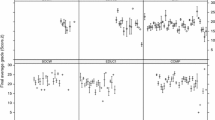Abstract
We investigate whether exam structure really matters in an economics and business statistics course by (1) determining how well performance on multiple choice questions alone expalins overall performance on exams composed of both multiple choice questions and problems, and (2) discovering whether various student characteristics have significantly different impacts on student performance on multiple choice questions versus problems. Our findings suggest that student scores on multiple-choice portions of exams do not adequately determine overall student performance, and that some students are predisposed to do better on multiple choice or problems depending on the characteristics they possess.(JEl A22, A29)
Similar content being viewed by others
References
Bach, G. L., and P. Saunders. 1965. “Economic Education: Aspirations and Achievements.”American Economic Review 55: 329–356.
Bennett, Randy E., Donald A. Rock, and Minhwei Wang. 1991. “Equivalence of Free-Response and Multiple-Choice Items”.Journal of Educational Measurement 28: 77–92.
Bridgeman, Brent. 1991. “Essays and Multiple Choice Tests as Predictors of College Freshman GPA”.Research in Higher Education 32: 319–332.
Kenkel, James L. 1981.Introductory Statistics for Management and Statistics. Boston, Mass: PWS/Duxbury.
Krieg, Randall G., and Bulent Uyar. 1997. “Correlates of Student Performance in Business and Economic Statistics”.Journal of Economics and Finance 21: 65–74.
Laband, D. N., and M. J. Piette. 1995. “Does Who Teaches Principles of Economics Matter?”AEA Papers and Proceedings 85: 335–338.
Maxwell, Nan L., and Jane S. Lopus. 1994. “The Lake Wobegon Effect in Student Self-Reported Data”.AEA Papers and Proceedings 84: 201–205.
Myatt, A., and C. Waddell. 1990. “An Approach to Testing the Effectiveness of the Teaching and Learning of Economics in High School”.Journal of Economic Education 21: 355–363.
Romer, D. 1993. “Do Students Go to Class? Should They?”Journal of Economic Perspectives 7: 167–74.
Saunders, Phillip, and William Walstad. 1990.The Principles of Economics Course: A Handbook for Instructors. New York: McGraw-Hill.
Taub, Ross E. 1993. “On the Equivalence of the Traits Assessed by Multiple Choice and Constructed-Response Tests”. InConstruction versus Choice in Cognitive Measurement, edited by R. E. Bennett and W. C. Ward. Hillsdale, NJ: Lawrence Elbaum.
Wainer, Howard, and David Thissen. 1993. “Combining Mutiple-Choice and Constructed-Response Test Scores: Toward a Marxist Theory of Test Construction”.Applied Measurement in Education 6: 103–118.
Walstad, William B., and William E. Becker. 1994. “Achievement Differences on Multiple-Choice and Essay Tests in Economics”.AEA Papers and Proceedings 84: 193–196.
Author information
Authors and Affiliations
Rights and permissions
About this article
Cite this article
Krieg, R.G., Uyar, B. Student performance in business and economics statistics: Does exam structure matter?. J Econ Finan 25, 229–241 (2001). https://doi.org/10.1007/BF02744525
Issue Date:
DOI: https://doi.org/10.1007/BF02744525




